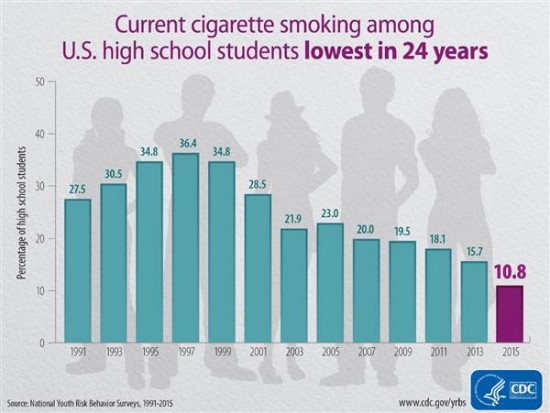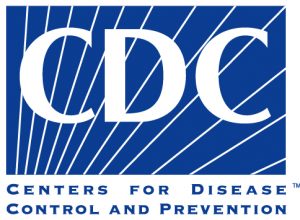Smoking Prevalence Among Teens Drops to All Time Low While E-Cigarette Use Increases
A new survey conducted by the Center for Disease Control and Prevention shows that smoking prevalence among teenagers has fallen by a staggering 31% between 2013 and 2015, while the use of electronic cigarettes in the same period has increased 24 times. So why are health groups still saying that e-cigs are a gateway to smoking?
Fresh data from the Youth Risk Behavior Survey (YRBS) reveals that current smoking prevalence among American high-school students has fallen from 15.7% to 10.8% in the last two years. This represents a new low and a 41% decrease from 2011. Frequent smoking also dropped from 5.6% to 3.4%, as has daily smoking, from 4.0% to 2.3%, and overall tobacco use – 24% to 18.5%.
Researchers also found that during the same 2011 – 2015 period during which smoking prevalence among youths dropped by 41%, e-cigarette use increased 24-fold. Surely there must be a connection there, right? But wait, that can’t be! Aren’t e-cig opponents always going on about how e-cigarettes are a gateway to smoking for kids? Why is this data showing the exact opposite?

But for some people, not even cold hard facts are enough to change their obviously preconceived ideas. Dr. Len Horovitz, a pulmonary specialist at Lenox Hill Hospital in New York City, told Health Day that “While cigarette smoking in high school students is at an all-time low, the rise of e-cigarette use poses a risk that teenagers will transition from ‘e’ to ‘real’ cigarettes.” Wow, it makes you wonder if he actually red the findings of this latest CDC survey, doesn’t it?
Others simply celebrate the drop in smoking prevalence while completing ignoring the role played by vaping in the historic decrease. Patricia Folan, director of the Center for Tobacco Control at Northwell Health, in Great Neck, New York said that the factors that likely contributed to this downward trend are “environmental tobacco bans, increased taxes on cigarettes, anti-tobacco media campaigns, as well as the removal of point-of-sale tobacco advertising from stores.” No mention of electronic cigarettes, despite the fact that 24% of teenagers said they had tried an e-cig in the 30 days prior to the survey.
The Campaign for Tobacco-Free Kids complained that “this survey also raises fresh concerns that other tobacco products, especially electronic cigarettes and cigars, are undermining overall efforts to reduce youth tobacco use and could be luring a new generation of kids into nicotine addiction.” They made their cold-turkey-or-bust approach to smoking very clear a long time ago, so it only makes sense that they see no benefit in a tool for tobacco harm reduction. Yes, nicotine is highly addictive, but it’s not what’s killing millions of people every year; tar, carbon dioxide and the hundreds of known carcinogens in tobacco smoke are.
Reducing smoking among teens by having them switch to vaping is in no way the ideal solution. Electronic cigarettes likely carry some risk – albeit orders of magnitude smaller than combustible tobacco – and a risk-free alternative would obviously be preferable, but the fact remains that quitting cold turkey is simply not an option for everyone.
Youth vaping should in no way be encouraged, and everyone agrees that the FDA was right to prohibit the sale of e-cigarettes to minors in its final regulations, but there is no doubt that they are helping to de-normalize smoking, and not the other way around. What all these health groups and organizations don’t want you to know is that if you eliminate the competition – and the FDA regulations in their current form will do just that – you once again increase demand for tobacco cigarettes. That, of course, means more investments in programs to curb smoking, which a lot of these groups are addicted to. You know what they say, “follow the money”.
















